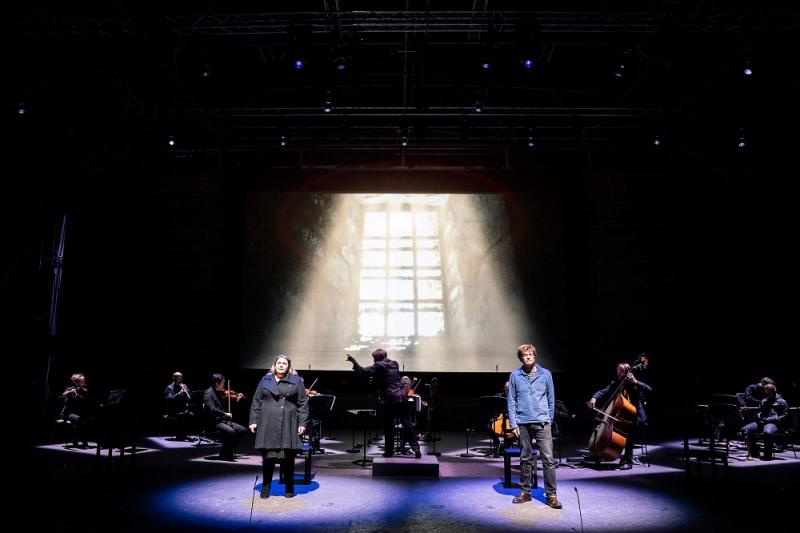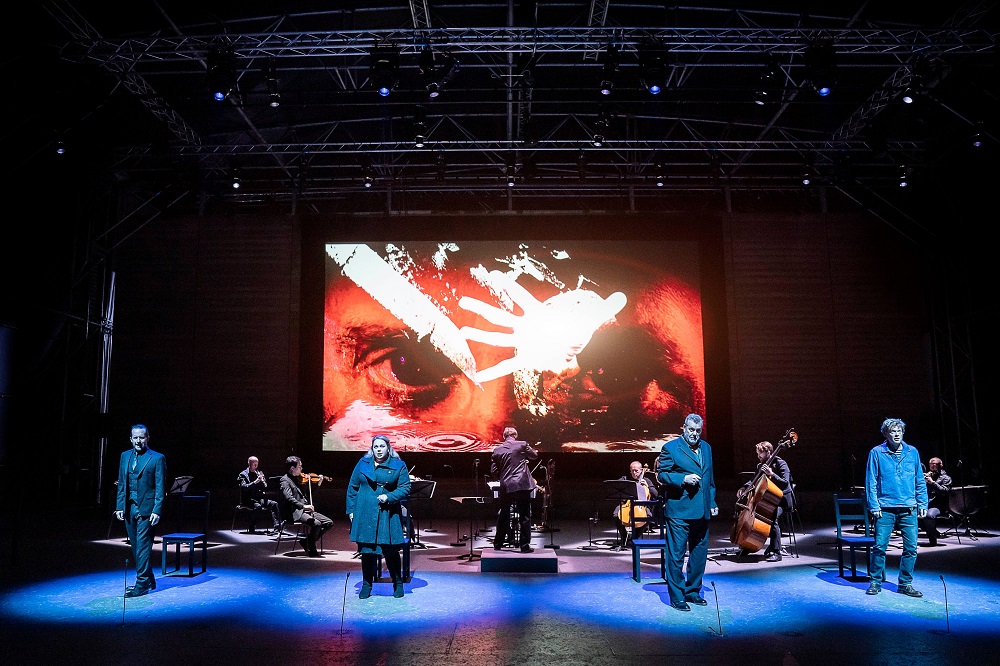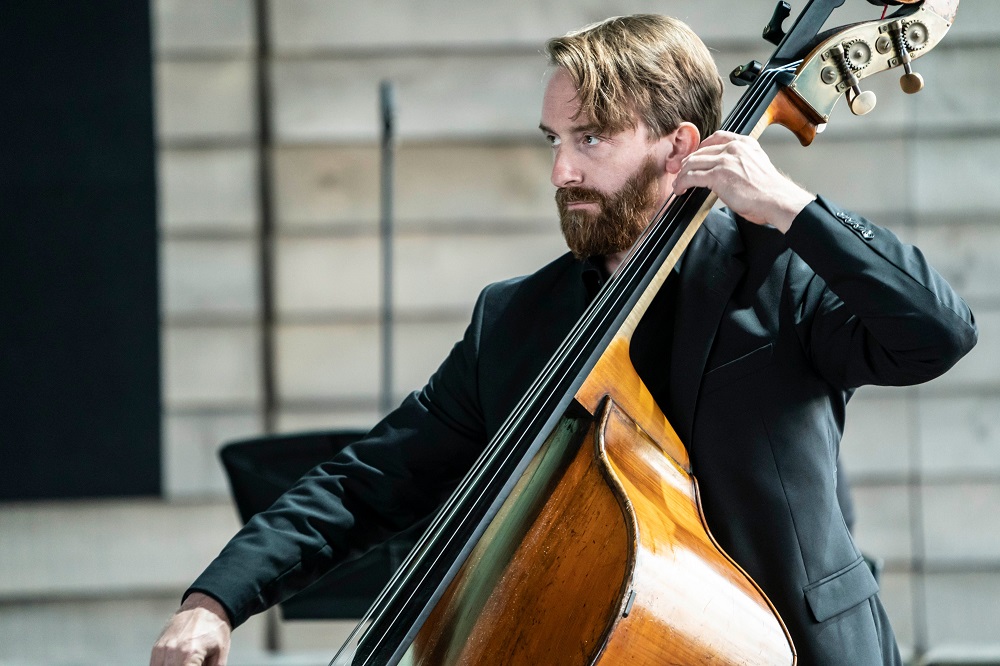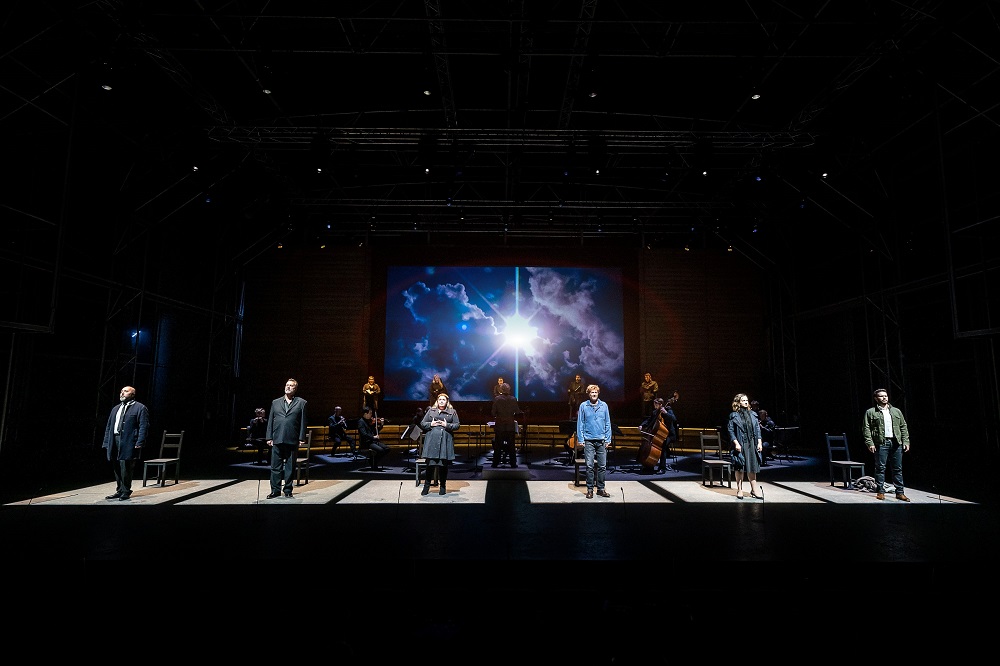Fidelio, Garsington Opera review - heart of darkness, light-filled liberation | reviews, news & interviews
Fidelio, Garsington Opera review - heart of darkness, light-filled liberation
Fidelio, Garsington Opera review - heart of darkness, light-filled liberation
Fine singers equalled by Philharmonia soloists in revelatory chamber-music Beethoven

It may be only six and a half months since many of us saw a production of Beethoven’s Fidelio in the opera house, but that was another world, and this post-lockdown admittance to Garsington Opera’s spacious, award-winning pavilion with its impressive acoustic was always going to be something extraordinary.
At first there was something of a cognitive dissonance between the views out to the trees and garden of the Wormsley Estate and the supposed confines of a prison yard. But the entire presentation, devised by Renaissance man Peter Mumford when Boyd presented Fidelio in Paris, focused the attention visually just as the ensemble on stage did aurally right from the start. Mumford‘s lighting, kept the main characters within their individual squares of light - replaced by blue pools in the first scene of Act Two - and the video projections in assocation with William Reynolds were very artistically filmed black and white prison scenes inside and out slowly transitioning into colour.  Pairs of eyes haunted us – four pairs in the blissful canon-quartet, later 15 as a pre-filmed Garsington male chorus delivered the Prisoners’ Chorus (there were also five choristers, two men and three women, to give the final liberation a special intimacy). At the moment when prison governor PIzarro thinks to achieve his vengeance on Florestan, his eyes have it - but not for long after Leonore's outstretched hand meets his dagger (pictured above). Without an interval, the journey from light to dark was unique – night had fallen outside by the time we reached the dungeon, and I’ve never felt so palpably in any production the subterranean chill (even the falling temperatures of the breezes from outside suggested the dankness). .
Pairs of eyes haunted us – four pairs in the blissful canon-quartet, later 15 as a pre-filmed Garsington male chorus delivered the Prisoners’ Chorus (there were also five choristers, two men and three women, to give the final liberation a special intimacy). At the moment when prison governor PIzarro thinks to achieve his vengeance on Florestan, his eyes have it - but not for long after Leonore's outstretched hand meets his dagger (pictured above). Without an interval, the journey from light to dark was unique – night had fallen outside by the time we reached the dungeon, and I’ve never felt so palpably in any production the subterranean chill (even the falling temperatures of the breezes from outside suggested the dankness). .
And these were merely the outer layers, though they went deep. Inward depth of expression came immediately from Galina Averina‘s Marzelline, less of a light soprano than usual – how artistically she echo-faded the top B flat of Katherine Broderick’s Leonore in that intensely moving final quintet with chorus – in repartee with Trystan Llŷr Griffiths' Jaquino. Stephen Richardson’s Rocco commanded his limited space with deft dramatic characterisation; if Andrew Foster Williams's prison governor Pizarro hardly offered as much authority, it was a more convincing shot than Simon Neal's in this year’s Royal Opera production.
 Lisa Davidsen’s Royal Opera Leonore was always going to be a hard act to follow, but Broderick (pictured right) has her own personality and dramatic-soprano sound, a little in line with the great Rita Hunter, the breadth of tone reined in to negotiate the lighter passages and runs (though her top notes were all secure, she wisely and stylishly took the lower option, up to an A rather than a B, at the end of the big aria, the voice thrillingly matched with the two superlative horns (Diego Incertis Sánchez and Kira Doherty).You might not expect to find the once lighter lyric tenor of Toby Spence tackling the killer role of Florestan; the end of his complementary set piece at the beginning of Act Two sounded as strenuous as most, but he did it, and the general under-pressure quality was backed up by dramatic conviction.
Lisa Davidsen’s Royal Opera Leonore was always going to be a hard act to follow, but Broderick (pictured right) has her own personality and dramatic-soprano sound, a little in line with the great Rita Hunter, the breadth of tone reined in to negotiate the lighter passages and runs (though her top notes were all secure, she wisely and stylishly took the lower option, up to an A rather than a B, at the end of the big aria, the voice thrillingly matched with the two superlative horns (Diego Incertis Sánchez and Kira Doherty).You might not expect to find the once lighter lyric tenor of Toby Spence tackling the killer role of Florestan; the end of his complementary set piece at the beginning of Act Two sounded as strenuous as most, but he did it, and the general under-pressure quality was backed up by dramatic conviction.
Given a chamber group as a kind of Greek chorus, the players also became dramatic participants, on a level with the singers. The acoustics loved the characterful woodwind solos, Timothy Rundle‘s oboe above all, which Beethoven asks to go insanely high for Florestan’s fevered vision, and which brought instant tears to the eyes in the timeless rapture just before the final hymn to Leonore. Astonishing, too, how much focus a string quintet could bring, and how Tim Gibbs‘s double bass (pictured below) could freeze the blood. One special focus was in how Beethoven slowly sheds the Mozartian mantle to pursue his own heart of darkness: it hit us first when Rocco sings in the duet with Pizarro of Florestan as “hardly alive, hovering like a shadow” and it threaded its way through the early numbers of Act 2 without impedance from any dialogue - the action is described on the screen – even in the melodrama at the start of No. 12, sounding more radical than ever.  That only made the liberation all the fresher. I don’t think I’ve ever heard the moment in the Act Two Quartet where Leonore interposes herself between Pizarro and Florestan singing “Töt erst sein Weib!” (“first kill his wife”) more thrillingly delivered than it was by Broderick, and the trumpet call of imminent liberation delivered another spine-tingling moment in the brilliant hands of Jason Evans. All this was the more remarkable when one remembers - I'd rather not - how director Tobias Kratzer botched the tension of the entire scene in the disastrous second act of the Royal Opera's Fidelio. For those of us who find a large-scale parade ground finale typical of Beethoven hammering in one nail too many, this ending delivered something much more convincing – a personal emancipation, the rhythms kept crisp and elevated by Boyd. You could only go out into the torch and brazier lit grounds the lighter after that.
That only made the liberation all the fresher. I don’t think I’ve ever heard the moment in the Act Two Quartet where Leonore interposes herself between Pizarro and Florestan singing “Töt erst sein Weib!” (“first kill his wife”) more thrillingly delivered than it was by Broderick, and the trumpet call of imminent liberation delivered another spine-tingling moment in the brilliant hands of Jason Evans. All this was the more remarkable when one remembers - I'd rather not - how director Tobias Kratzer botched the tension of the entire scene in the disastrous second act of the Royal Opera's Fidelio. For those of us who find a large-scale parade ground finale typical of Beethoven hammering in one nail too many, this ending delivered something much more convincing – a personal emancipation, the rhythms kept crisp and elevated by Boyd. You could only go out into the torch and brazier lit grounds the lighter after that.  All this was done at the highest level, circumstances notwithstanding. And I should give a special shout-out to the amazing work of Garsington’s education and outreach programmes during lockdown, making an opera related to Fidelio’s theme to the imprisonment within themselves sometimes felt by stroke sufferers; a real-life Leonore spoke movingly of how far her Florestan felt from her at first in a four-minute film shown at the beginning of the evening. May a company which has in the past few years come up to Glyndebourne standards, and sometimes excelled it in productions – I think especially of Death in Venice, Idomeneo with Spence and The Cunning Little Vixen – return next summer all the stronger.
All this was done at the highest level, circumstances notwithstanding. And I should give a special shout-out to the amazing work of Garsington’s education and outreach programmes during lockdown, making an opera related to Fidelio’s theme to the imprisonment within themselves sometimes felt by stroke sufferers; a real-life Leonore spoke movingly of how far her Florestan felt from her at first in a four-minute film shown at the beginning of the evening. May a company which has in the past few years come up to Glyndebourne standards, and sometimes excelled it in productions – I think especially of Death in Venice, Idomeneo with Spence and The Cunning Little Vixen – return next summer all the stronger.
rating
Explore topics
Share this article
The future of Arts Journalism
You can stop theartsdesk.com closing!
We urgently need financing to survive. Our fundraising drive has thus far raised £49,000 but we need to reach £100,000 or we will be forced to close. Please contribute here: https://gofund.me/c3f6033d
And if you can forward this information to anyone who might assist, we’d be grateful.

Subscribe to theartsdesk.com
Thank you for continuing to read our work on theartsdesk.com. For unlimited access to every article in its entirety, including our archive of more than 15,000 pieces, we're asking for £5 per month or £40 per year. We feel it's a very good deal, and hope you do too.
To take a subscription now simply click here.
And if you're looking for that extra gift for a friend or family member, why not treat them to a theartsdesk.com gift subscription?
more Opera
 Albert Herring, English National Opera review - a great comedy with depths fully realised
Britten’s delight was never made for the Coliseum, but it works on its first outing there
Albert Herring, English National Opera review - a great comedy with depths fully realised
Britten’s delight was never made for the Coliseum, but it works on its first outing there
 Carmen, English National Opera review - not quite dangerous
Hopes for Niamh O’Sullivan only partly fulfilled, though much good singing throughout
Carmen, English National Opera review - not quite dangerous
Hopes for Niamh O’Sullivan only partly fulfilled, though much good singing throughout
 Giustino, Linbury Theatre review - a stylish account of a slight opera
Gods, mortals and monsters do battle in Handel's charming drama
Giustino, Linbury Theatre review - a stylish account of a slight opera
Gods, mortals and monsters do battle in Handel's charming drama
 Susanna, Opera North review - hybrid staging of a Handel oratorio
Dance and signing complement outstanding singing in a story of virtue rewarded
Susanna, Opera North review - hybrid staging of a Handel oratorio
Dance and signing complement outstanding singing in a story of virtue rewarded
 Ariodante, Opéra Garnier, Paris review - a blast of Baroque beauty
A near-perfect night at the opera
Ariodante, Opéra Garnier, Paris review - a blast of Baroque beauty
A near-perfect night at the opera
 Cinderella/La Cenerentola, English National Opera review - the truth behind the tinsel
Appealing performances cut through hyperactive stagecraft
Cinderella/La Cenerentola, English National Opera review - the truth behind the tinsel
Appealing performances cut through hyperactive stagecraft
 Tosca, Royal Opera review - Ailyn Pérez steps in as the most vivid of divas
Jakub Hrůša’s multicoloured Puccini last night found a soprano to match
Tosca, Royal Opera review - Ailyn Pérez steps in as the most vivid of divas
Jakub Hrůša’s multicoloured Puccini last night found a soprano to match
 Tosca, Welsh National Opera review - a great company reduced to brilliance
The old warhorse made special by the basics
Tosca, Welsh National Opera review - a great company reduced to brilliance
The old warhorse made special by the basics
 BBC Proms: The Marriage of Figaro, Glyndebourne Festival review - merriment and menace
Strong Proms transfer for a robust and affecting show
BBC Proms: The Marriage of Figaro, Glyndebourne Festival review - merriment and menace
Strong Proms transfer for a robust and affecting show
 BBC Proms: Suor Angelica, LSO, Pappano review - earthly passion, heavenly grief
A Sister to remember blesses Puccini's convent tragedy
BBC Proms: Suor Angelica, LSO, Pappano review - earthly passion, heavenly grief
A Sister to remember blesses Puccini's convent tragedy
 Orpheus and Eurydice, Opera Queensland/SCO, Edinburgh International Festival 2025 review - dazzling, but distracting
Eye-popping acrobatics don’t always assist in Gluck’s quest for operatic truth
Orpheus and Eurydice, Opera Queensland/SCO, Edinburgh International Festival 2025 review - dazzling, but distracting
Eye-popping acrobatics don’t always assist in Gluck’s quest for operatic truth
 MARS, Irish National Opera review - silly space oddity with fun stretches
Cast, orchestra and production give Jennifer Walshe’s bold collage their all
MARS, Irish National Opera review - silly space oddity with fun stretches
Cast, orchestra and production give Jennifer Walshe’s bold collage their all

Add comment